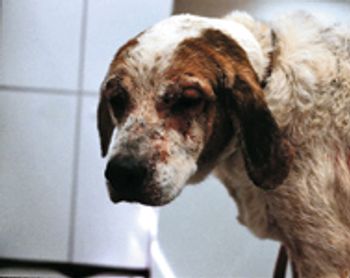
A discussion on diagnosing and treating adverse food reactions.

A discussion on diagnosing and treating adverse food reactions.

Thyroid hormone is necessary to initiate the anagen phase of hair growth and all hair follicles, except those on the head and distal limbs, appear to be under its influence.

Antihistamines have variable efficacy in atopic dogs. If at least 3 different antihistamines are tried in an individual dog, you can reasonably expect to find one that works 25-40% of the time.

Got a thin skin about shrinking practice revenue? Offer relief for itchy patients and scratch your own itch to grow the bottom line.

Many otic medications require owners to blindly squeeze the bottle, leaving them unsure as to how much, if any, medication went into their pets' ears.

House dust mites are the most common allergen in people, dogs and cats. How did this get to be so common, and why is dust mite allergy such a problem?

There is more to know than Depomedrol!!!

Case 1 History: Questions to ask

Canine otitis externa is certainly one of the most common problems veterinarians are dealing with in small animal practice. However, recurrent ear diseases can be very challenging to manage and be quite frustrating for the practitioner as well as for the pet owner.

The following mystery cases will be analyzed from initial presentation to the final diagnosis, treatment, and follow up.

Otitis externa is an acute or chronic inflammation of the epithelium of the external ear canal which may also involve the pinna. It is a common disorder which may present as a primary complaint or concurrently with other problems.

Hair is rich in protein and its growth requires adequate nutrition and the metabolic capability to process and utilize those nutrients. The hair follicle has three phases of growth: anagen, catagen, and telogen.

Zinc responsive dermatosis is a nutritional skin disease that can be categorized as syndromes I or II.

Pruritus 1. Unpleasant sensation that provokes desire to scratch.

Dogs and cats are often presented with a complaint of scratching and chewing resulting self-inflicted trauma. Pruritus is a very unspecific clinical sign which can be caused by many different problems such as various ectoparasites, microbial infections and a wide range of hypersensitivities.

In the field of veterinary medicine we see a constant search for newer, more effective, and convenient but inexpensive drugs with lesser side effects. Not only new drugs are interesting, but old drugs are occasionally rediscovered for new indications.

Deadly dermatoses are defined as 1. Lethal diseases for the pet.

Virtually all internal diseases will eventually have cutaneous manifestations such as a dull dry coat which sheds easily and is not replaced at a normal rate. In these conditions, the clinical signs of the internal disease occur first and predominate, leading the clinician down the correct diagnostic pathway.

Skin and ear problems are very common reasons for dogs and cats being presented to a veterinarian. These animals can suffer from many different skin diseases with a wide range of underlying causes.

Concurrent claw problems are not unusual in many skin diseases, but rare as the only dermatological problem. The most common disease affecting single claws are: trauma, bacterial or fungal infections; the most common condition affecting multiple claws would be onychodystrophy.

Cutaneous manifestations of internal disease exist in both human and veterinary medicine. Many endocrine skin diseases start with bilaterally symmetrical alopecia as the first clinical and presenting sign.

The most common hypersensitivities affecting dogs and cats are: flea bite hypersensitivity, food adverse reaction (food allergy & food intolerance), and atopy.

History (70% of the battle); physical examination (20% of the battle)

This was a commonly diagnosed disease in the late 70s and early 80s. It is rarely diagnosed today. With current day tests for infectious diseases like leishmaniasis and our understanding of the complexities of cutaneous drug reactions, most cases of "lupus" are actually not "lupus" and might be a curable disease.

Currently there are 3 morphologically separate species of follicularly oriented demodex mites in the dog: Demodex canis, Demodex injae, and Demodex ?. The unnamed species has a very short tail but is not Demodex gatoi of the cat.